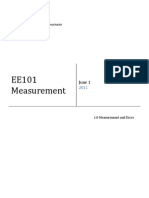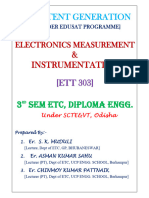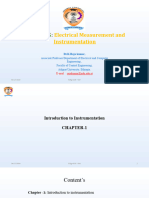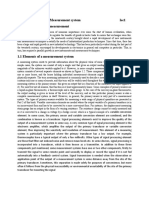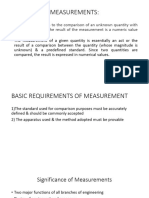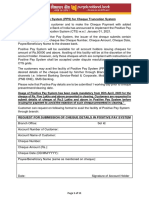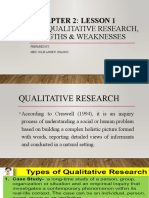Chap 1 - Measurement Error
Chap 1 - Measurement Error
Uploaded by
Huan HuanCopyright:
Available Formats
Chap 1 - Measurement Error
Chap 1 - Measurement Error
Uploaded by
Huan HuanOriginal Description:
Copyright
Available Formats
Share this document
Did you find this document useful?
Is this content inappropriate?
Copyright:
Available Formats
Chap 1 - Measurement Error
Chap 1 - Measurement Error
Uploaded by
Huan HuanCopyright:
Available Formats
MEASUREMENT AND ERRORS EJ101 / UNIT 1/ 1
1.1 MEASUREMENT
1.1.1 INTRODUCTION
Measuring is a basically used to monitor a process or operation, or as well as the controlling
process. For example: thermometers, barometers, anemometers are used to indicate the
environmental conditions.
There is always a need for improvement and development of new equipment to solve
measurement problems.
The major problem encountered with any measuring instrument is the error. It is important to
select appropriate measuring instrument or measurement method to minimize error.
In early days, deflection type instrument with scale and movable pointer were used to indicate
the quantities of measurement. The angle of deflection of the pointer is a function and
therefore analogous to the value of the electrical quantity being measured.
Analog instrument is identifying as deflection-type instruments that display in decimal form
the value of the quantity being measured. Newer instrument are called the digital instrument
displays measurement quantities in digit form with LCD or 7 segment display.
1.1.2 ELEMENTS OF ELECTRONICS INSTRUMENTS
Transducer Signal Modifier Indicating device
Figure 1.1: Element of electronic instruments
Transducer Converts nonelectrical signal into an electrical signal. Therefore, a transducer
is required only if the quantity to be measured nonelectrical (e.g pressure)
Signal modifier To process the incoming electrical signal to make it suitable for application
to be indicating device. It could be amplifier, attenuator, volatge divider,
waveshaping circuit, modulator, multiplexer, rectifier, choppers and etc.
Indicating device generally a deflection type meter for such general purpose instruments
as voltmeters, current meters or choppers.
1.1.3 ELEMENTS OF MEASUREMENT SYSTEM
a. Primary sensing element
The physical quantity under measurement, called the measurand, makes its first contact with
the primary sensing element of a measuring system.
The measurand is always disturbed by the act of measurement, but good instruments are
designed to minimise this effect.
Primary sensing elements may have non-electrical input and output such as a spring,
manometer or may have an electrical input and output such as spring, manometer or may
have an electrical input and output such as a rectifier.
In case the primary sensing element has a non-electrical input and output, then it is
converted into an electrical signal by means of a transducer.
The transducer is defined as a device, which when actuated by one form energy, is capable
of converting it into another form of energy.
Mohd Khairul Muzhafar - Julai 2010
JKE, PKK
MEASUREMENT AND ERRORS EJ101 / UNIT 1/ 2
Many a times certain operations are to be performed on the signal before its further
transmission so that interfering sources are removed so that the signal may not get distorted.
The process maybe linear such as ampification, attenuation, integration, differentiation,
adition and subtraction or non-linear such as modulation, detection, sampling, filtering,
chopping and clipping.
The process is called the signal conditioning. So signal conditioner follows the primary
sensing element or transducer, as the case maybe.
b. Variable conversion element
Now the output, which is in the form of electrical signal (voltage or current, frequency or some
other electrical parameter), may or may not suit to the system.
For the instrument to perform the desired function, it maybe necessary to convert this output
to some other suitable form while retaining the information content of the original signal.
For example, if output is in analog form and the next stage of the system accepts the input
only in digital form, then analog digital converter will be required.
Many instruments do not requireany variable conversion element, while others require more
than one element.
c. Variable manipulation element
The function of variable manipulation element, as the name indicates, is to manipulate the
signal presented to it while preserving the original nature of the signal.
For example, an electronic amplifier converts a small low voltage input signal into high
voltage output signal.
Thus voltage amplifier acts as a variable manipulation element.
It is not necessary that this element follows the variable conversion elements as shown in
figure 1.1. In many cases it may precede the variable conversion element.
When the elements of an instrument are to be physically separated out, it becomes
necessary to transmit data from one to another.
The element performing this function is called the data transmission element.
For example space crafts are physically separated from the earth where the control stations
guiding their movement are located.
Input Primary Transducer Signal
sensing conditioner
Measurand
element
Data Data Variable Variable
presentation transmission manipulation conversion
element element element element
Figure 1.2 : Functional elements of an instrumentation system
d. Data presentation element
The information regarding measurand (quantity to be measured) is to be conveyed to the
personnel handling the instrument or the system for monitoring, controlling or analysis
purpose.
Mohd Khairul Muzhafar - Julai 2010
JKE, PKK
MEASUREMENT AND ERRORS EJ101 / UNIT 1/ 3
The information conveyed must be in a form intelligible to the personnel. Such devices (read
out or display) may be in analog or digital format.
The simplest form a display device is the common panel meter with some kind of calibrated
scale and pointer. In case, the data is to be recorded.
Recoders like magnetic tape maybe used. For control and analysis purpose computers
maybe used.
1.1.3.1 TYPICAL INSTRUMENTATION SYSTEM
Monitoring of process and operations
One of the most important function of an instrumentation system is monitoring of process or
operation. It simply indicates the value or condition of the parameter under study in the
process. For example, an ammeter or a frequency meter indicates the value of current or
frequency , under measurement or monitoring, at a particular instant.
Control of processes and operations
In order to control the process and operation variable like current, voltage, power,
temperature, pressure or humidity, these quantities are required to be measured at
appropriate points in the individual plant.
Engineering analysis
Many engineering applications are required to be analysed therotically as well as
experimentally. Experimentally engineering analysis have many uses and some of them are
listed below:
- Testing of validity of theoretical predictions
- Determination of system parameters, variables and performance indices
- Doing reseach and development process
1.2 ERROR IN MEASUREMENT
1.2.1 INTRODUCTION
A measurement is the process of comparing an unknown quantity with an accepted
standard quantity.
The measurement is a quantitative measurement of true value or expected value.
There are external factors that may affect the true value.
The degree to which a measurement confirms to the expected value is expressed in
terms of the error of the measurement.
Error maybe expressed either as absolute or as a percent of error. It is defined as the
deviation of reading from the expected value of the measured variable.
1.2.2 TYPES OF ERRORS
a. GROSS ERROR
Gross error is generally the fault of the person using the instruments and is due to such
things as incorrect reading of instruments, incorrect recording of experimental data or
incorrect use of instruments.
b. SYSTEMATIC ERROR
Due to instrument, environment or observational error, these quantities recur if several
measurements are made of the same quantity under the same conditions.
Mohd Khairul Muzhafar - Julai 2010
JKE, PKK
MEASUREMENT AND ERRORS EJ101 / UNIT 1/ 4
i) Instruments errors
These errors maybe due to friction in the bearings of the meter movement,
incorrect spring tension, improper calibration, or faulty instruments. Instruments
error can be reduced by proper maintenance, use and handling of instruments.
ii) Environment errors
Subjected to harsh environment such as high temperature, pressure, or humidity
or strong electrostatic or electromagnetic fields, may have detrimental effects,
thereby causing error.
iii) Observational errors
Parallel error introduced in reading a meter scale and the error of estimation
when obtaining a reading from a meter scale.
c. RANDOM ERROR
These errors that remain after gross and systematic errors have been substantially
reduced or at least accounted for. Accumulation of small effects and may be of real
concern in high degree of accuracy measurement.
d. ABSOLUTE ERROR
Absolute error is the difference between the expected value of the variable and the
measured variable, or
Absolute error = expected value measured value
In terms of error percentage, it is:
Percent error = Absolute error x 100
Expected value
e. RELATIVE ERROR
If a resistor is known to have a resistance of 500 with a possible error of 50 , the
50 is an absolute error. This is because 50 is stated as an absolute quantity, not
as a percentage of the 500 resistance. When the error is expressed as a percentage or
as a fraction of the total resistance, it becomes a relative error. Thus, the 50 is
10%, relative to 500 , or 1/10 of 500. So the resistance can be specified as R = 500
10%.
f. LIMITING ERROR
It is defined as the limits of deviations from the specified value. Manufacturer of a certain
voltmeter may specify the instrument to be accurate within 2% with full-scale deflection.
A full scale reading is guaranteed to be within the limits of 2% of a perfectly accurate
reading. The readings that are less than full scale, the limiting error will increase.
Therefore, it is important to obtain measurements as close as possible to full scale.
For example, the nominal magnitude of a resistor is 90 with a limiting error of 5 .
The magnitude of the resistor will be between the limits 90 5 .
Mohd Khairul Muzhafar - Julai 2010
JKE, PKK
MEASUREMENT AND ERRORS EJ101 / UNIT 1/ 5
FORMULA
ABSOLUTE ERROR = EXPECTED VALUE MEASURED VALUE
% ERROR = ABSOLUTE ERROR X 100%
EXPECTED VALUE
% ACCURACY = 100% % ERROR
MAGNITUDE OF LIMITING ERROR = ACCURACY x FULL SCALE
EXAMPLE 1.1
Based on figure below, a voltage source 20 V is parallel connected with two resistors, R1 = 15k
dan R2 = 7k. A voltmeter is connected across resistor R1 and its shown a value 19.5 V.
Calculate percentage of error and percentage of accuracy of the voltmeter.
20V V
R1 R2
[Answer: Percentage of error = 2.5%, Percentage of accuracy = 97.5%]
EXAMPLE 1.2
A voltmeter with range 0 - 150 V has a accuracy 3% at full scale 50 V and 95 V during the
measurement. Calculate the magnitude of error and percentage of error for each value.
[Answer: Magnitude of error = 4.5 V, Percentage of error = 9 %, 4.74 %]
EXAMPLE 1.3
An ammeter with accuracy 2% has full scale current 100 A. Calculate the maximum and
minimum value from the ammeter when it used to measure current:
i) 70 A ii) 45 A
[Answer: i) 72 A and 68 A ii) 47 A and 43 A]
EXAMPLE 1.4
Calculate the maximum and minimum value for each component below:
i. 200F + 10% [Answer: 220 F]
ii. 1000Hz 5% + 10% [Answer: 1100 Hz, 950 Hz]
iii. 560 + 10 [Answer: 570 ]
EXAMPLE 1.5
The measured value of a resistance is 10.25, where as its value is 10.22. Determine the
absolute error of measurement. [Answer: 0.03 ]
Mohd Khairul Muzhafar - Julai 2010
JKE, PKK
MEASUREMENT AND ERRORS EJ101 / UNIT 1/ 6
EXAMPLE 1.6
A wattmeter reads 25.34 watts. The absolute error in the measurements is -0.11 watt. Determine
the expected value of power. [Answer: 25.45 watts]
EXAMPLE 1.7
The measured value of a capacitor is 205.3 F, where as its expected value is 201.4 F.
Determine the relative error. [Answer: 0.0194 or 1.94%]
EXAMPLE 1.8
The inductance of an inductor is specified as 20H 5% by a manufacturer. Determine the limits
of inductance between which it is guaranteed. [Answer: 20 1H]
EXAMPLE 1.9
A 0-25 A ammeter has a guaranteed accuracy of 1% of full scale reading. The current measured
by this instrument is 10A. Determine the limiting error in percentage. [Answer: 2.5%]
EXAMPLE 1.10
A 0-250 V voltmeter has a guaranteed accuracy of 2% of full scale reading. The voltage
measured by the voltmeter is 150 volts. Determine the limiting error in percentage.
[Answer: 3.33%]
1.2.3 CHARACTERISTCS OF MEASUREMENT
a. Accuracy
The degree of exactness (closeness) of a measurement compared to the expected value.
b. Precision
A measure of the consistency or repeatability of measurements, i.e. successive reading
do not differ.
c. Resolution
The smallest change in a measured variable to which instrument will respond
d. Significant figure
The number of significant figures used in a measured quantity indicate the precision of
measurement.
e. Sensitivity
The ratio of the change in output of the instrument to a change of input or measured
variable
f. Instrument
A device or mechanism used to determine the present value of the quantity under
measurement.
g. Measurement
The process of determining the amount, degree or capacity by comparison (direct or
indirect) with the accepted standards of the system units being used.
h. Expected value
The design value, i.e. the most probable value that calculations indicate one should
expect to measure.
i. Error
The deviation of the true value from the desired value
Mohd Khairul Muzhafar - Julai 2010
JKE, PKK
MEASUREMENT AND ERRORS EJ101 / UNIT 1/ 7
1.3 STANDARD CLASSIFICATION IN MEASUREMENT
a. International standards
- This standard is defined by international agreement.
- Maintain and periodically check at International Bureau of Weight and Measures in
Paris.
- Represent certain units of measurement to the closet accuracy attainable by the
science and technology of measurement.
- Used for the purpose of calibration and comparison.
b. Primary standards
- Maintain at the national standard laboratories in differnent countries
- The principal function is the calibration and verification of secondary standards.
c. Secondary standards
- Basic reference standards used by measurement and calibration laboratories in the
industry to which they belong.
- Each laboratory periodically sends its secondary standards to the national standards
laboratory for calibration.
- After calibration the secondary standards are returned to the industrial laboratory with
a certification of measuring accuracy in terms of a primary standard.
d. Working standards
- Are the pricipal tools of a measurements laboratory.
- Used to check and calibrate the instruments used in the laboratory or to make
comparison measurements in industrial application.
ACTIVITIES
1. Four resistors are connected as serial and its value as below:
R1 = 36 5% R2 = 75 5%
R3 = 100 10% R4 = 85 20%
Calculate the maximum percentage of error for total resistors above.
[Answer: 11%]
2. A voltmeter with a measurement range of 0 150 V has a 1% full skill deflection. This
voltmeter is used to measure a voltage of 83 V. Calculate the percentage of error for
this reading. [Answer: 1.81%]
3. Refer to figure below, calculate the percentage of error and percentage of accuracy if
ammeter shown 12 mA.
1 k
mA
500
15V
Mohd Khairul Muzhafar - Julai 2010
JKE, PKK
MEASUREMENT AND ERRORS EJ101 / UNIT 1/ 8
[Answer: Percentage of error = 20%, Percentage of accuracy = 80%]
4. Three different type of resistance have different values of R1 = 10 k 5%, R2 = 22
k 2% dan R3 = 6.8 k 5% that are connected in series. Calculate the
percentage of maximum error when their total resistance is measured.
[Answer: 3.299%]
5. One ammeter is used to measure a circuit as shown below, the meter shows a
reading of 2.8 A. How much is percentage of error and percentage of accuracy for
this meter?
A
5V 3
[Answer: Percentage of error = 12%, Percentage of accuracy = 88%]
6. One equation is used to determine the value for R4 as R4 = (R1R2) / R3 where the
value of R1 = 500 1%, R2 = 615 1%, R3 = 100 0.5%. Obtain the error rate
for R4. [Answer: 3075 76.875 ]
7. A PMCC instrument with a 100 turn coil has a magnetic flux density in its air gaps of
B = 0.2 T. The coil dimensions are D = 1 cm and l = 1.5 cm. Calculate the torque on
-6
the coil for a current of 1mA. [Answer: TD = 3x10 N.m]
8. A voltmeter and an ammeter are to be used to determine the power dissipated in a
resistor. Both instrument are guaranteed to be accurate within 1% at full-scale
deflection. If the voltmeter reads 80V on its 150V range and the ammeter reads
70mA on its 100 mA range, determine the limiting error for the power calculation.
[Answer: 3.30%]
Mohd Khairul Muzhafar - Julai 2010
JKE, PKK
You might also like
- SL2007 483Document7 pagesSL2007 483Subramoniam MarineNo ratings yet
- Instrumentation and ControlDocument53 pagesInstrumentation and ControlDaniel D Danso100% (1)
- Module 1Document38 pagesModule 1october87No ratings yet
- Yhgv PDFDocument253 pagesYhgv PDFNor Allysha KysaraNo ratings yet
- M1a Units and DimensionsDocument18 pagesM1a Units and DimensionsMadangle JungleNo ratings yet
- Instrumentation For StudentsDocument157 pagesInstrumentation For StudentsBalasubramanyaNo ratings yet
- Electrical Measurements and Instrumentation (Introduction To Instrumentation Engineering) October 2019Document25 pagesElectrical Measurements and Instrumentation (Introduction To Instrumentation Engineering) October 2019tesfaye meberateNo ratings yet
- Instrumentation & Measurement (ME342) : Chapter 1: Fundamentals of Measurement SystemsDocument19 pagesInstrumentation & Measurement (ME342) : Chapter 1: Fundamentals of Measurement SystemsMajid ArabiatNo ratings yet
- Lecture - 1 - EEE 2209Document12 pagesLecture - 1 - EEE 2209eesaruhullahansariNo ratings yet
- LMS 20240713 095611Document4 pagesLMS 20240713 095611filmstory07No ratings yet
- Chapter - 1 - General Principles of MeasurementDocument53 pagesChapter - 1 - General Principles of MeasurementmarNo ratings yet
- Vtu E-Learning Notes On:: Electrical and Electronic Measurements and InstrumentationDocument19 pagesVtu E-Learning Notes On:: Electrical and Electronic Measurements and InstrumentationKrishna ReddyNo ratings yet
- Process Instrumentation Basic DefinitionsDocument49 pagesProcess Instrumentation Basic DefinitionsMantuomNo ratings yet
- Book of Sir Naveed RamzanDocument175 pagesBook of Sir Naveed RamzanSomaan Alam100% (1)
- SBMA1301 Measurement SystemDocument161 pagesSBMA1301 Measurement SystemMalathy NNo ratings yet
- Lec 2Document22 pagesLec 2mgeneralworkNo ratings yet
- Measurement Instruments Module 1Document2 pagesMeasurement Instruments Module 1naveenkumar.s2022eeeNo ratings yet
- Unit 1 Introduction To Instrumentation-Part 1Document62 pagesUnit 1 Introduction To Instrumentation-Part 1Akshat RawatNo ratings yet
- Introduction Lecture On Measurement and InstrumentationDocument24 pagesIntroduction Lecture On Measurement and InstrumentationabrhamNo ratings yet
- MENG 304: Mechanical Measurements Lect - 02: Presented By: Hussein Fouad Mohamed AliDocument26 pagesMENG 304: Mechanical Measurements Lect - 02: Presented By: Hussein Fouad Mohamed AliWalid KhaledNo ratings yet
- Introduction To Instrumentation System: by Prof - Bikash MohantyDocument25 pagesIntroduction To Instrumentation System: by Prof - Bikash MohantyKaran Deep SinghNo ratings yet
- UNIT I Introduction PPT InstrumentationDocument55 pagesUNIT I Introduction PPT InstrumentationSurendra YadavNo ratings yet
- Eee305 - 2Document11 pagesEee305 - 2Azharul IslamNo ratings yet
- Data AcquisitionDocument18 pagesData Acquisitionwanted_JMTINo ratings yet
- Instrumentation and Measurements - MaterialDocument150 pagesInstrumentation and Measurements - MaterialYAVANA BNo ratings yet
- Measurement and ErrorDocument18 pagesMeasurement and Errorezat93100% (1)
- Lecture 1Document34 pagesLecture 1enockiptoo213No ratings yet
- Process Control & InstrumentationDocument49 pagesProcess Control & InstrumentationMantuomNo ratings yet
- Ins Notes r15Document93 pagesIns Notes r15s masumNo ratings yet
- MEchanical MEasurement NotesDocument24 pagesMEchanical MEasurement NotesAamir Siwani100% (1)
- 66 - 15575 - EC 732 - 2014 - 1 - 1 - 2 - Chapter 1Document11 pages66 - 15575 - EC 732 - 2014 - 1 - 1 - 2 - Chapter 1ዘረአዳም ዘመንቆረርNo ratings yet
- UNIT I Introduction ACTDocument56 pagesUNIT I Introduction ACTSelva LakshmiNo ratings yet
- I&m 1Document22 pagesI&m 1Aleeza AshfaqueNo ratings yet
- Rohini 66482883011Document7 pagesRohini 66482883011Kirthika venkateshNo ratings yet
- Measurement and Sensors - Lecture1Document17 pagesMeasurement and Sensors - Lecture1Atharva Soni100% (1)
- Measurements and Instrumentation AssignmentDocument68 pagesMeasurements and Instrumentation AssignmentPradeep Kumar VermaNo ratings yet
- 1.unit 1 IcsDocument79 pages1.unit 1 IcsSrinivas KosuriNo ratings yet
- Chap 1 PPT Instr. & Meas PCE 4203 From GUDocument43 pagesChap 1 PPT Instr. & Meas PCE 4203 From GUTemesgen workiye100% (1)
- Presntation (Installing Instrumentation and Control Devices)Document35 pagesPresntation (Installing Instrumentation and Control Devices)habtemariam molla100% (1)
- Lec1.0 - Introduction To Instrumentation & Its ApplicationsDocument54 pagesLec1.0 - Introduction To Instrumentation & Its ApplicationsMuhammad Naufal RamzNo ratings yet
- Chapter 1 Error Mesurement PDFDocument99 pagesChapter 1 Error Mesurement PDFanesseNo ratings yet
- Lecture 2-ADocument23 pagesLecture 2-AEslam SarwatNo ratings yet
- Measurement: Measuring InstrumentsDocument6 pagesMeasurement: Measuring InstrumentsSubhransu MohapatraNo ratings yet
- Chaper OneDocument40 pagesChaper OneAbrhamNo ratings yet
- Electronics Instrumentation 15EI251 PDFDocument94 pagesElectronics Instrumentation 15EI251 PDFlvrevathiNo ratings yet
- 2 Laplace TableDocument7 pages2 Laplace TableVinaya NaralasettyNo ratings yet
- EIMDocument97 pagesEIMprajapatisavitur318No ratings yet
- Unit 1Document9 pagesUnit 1Naveen KumarNo ratings yet
- Chapter 1.1 & 1.2 General Principles & Basic Concepts of MeasurementsDocument53 pagesChapter 1.1 & 1.2 General Principles & Basic Concepts of MeasurementsdfNo ratings yet
- Lec 0 Introduction To MeasurementDocument5 pagesLec 0 Introduction To MeasurementKhalifa EltayebNo ratings yet
- Assignment With AnswersDocument19 pagesAssignment With AnswersMythily VedhagiriNo ratings yet
- Measurement & Instrumentation - 22CDocument80 pagesMeasurement & Instrumentation - 22Cgoodness gloriousNo ratings yet
- Lecture 2 2022Document56 pagesLecture 2 2022abdallaNo ratings yet
- Instrumentation and Control SystemsDocument30 pagesInstrumentation and Control Systemsabhiram pasupuletiNo ratings yet
- Introduction To Measurements: Department of Electronics and Communication EngineeringDocument17 pagesIntroduction To Measurements: Department of Electronics and Communication EngineeringKavitha A KNo ratings yet
- MI - Unit 1 - CLASS NOTESDocument74 pagesMI - Unit 1 - CLASS NOTESvbarath58No ratings yet
- Chapter NO.01 Introduction, Pressure - Temperature MeasurementDocument82 pagesChapter NO.01 Introduction, Pressure - Temperature Measurementtanmayeeingale22No ratings yet
- Electronic MeasurementsDocument66 pagesElectronic MeasurementsBenson Mansingh P MNo ratings yet
- EC-1 (Measurement and Instrumentation) Unit 1 Notes (I)Document11 pagesEC-1 (Measurement and Instrumentation) Unit 1 Notes (I)kashifNo ratings yet
- Course Code: Eceg 4155 Pre-Requisite: Intro To CNRTL Eng'G (Eceg3153) CHR - HRS: 3 (2+3) Year: Iv Semester: I Program: Ug Regular 2019/20Document37 pagesCourse Code: Eceg 4155 Pre-Requisite: Intro To CNRTL Eng'G (Eceg3153) CHR - HRS: 3 (2+3) Year: Iv Semester: I Program: Ug Regular 2019/20yohansgebru17No ratings yet
- 3D Attack - 2005 - 04Document56 pages3D Attack - 2005 - 04varis6No ratings yet
- Warranty Letter PackagingDocument2 pagesWarranty Letter PackagingsistemasdegestiongrupodoronNo ratings yet
- Direct TV Channel LineupDocument4 pagesDirect TV Channel Lineupgeneral_calamityNo ratings yet
- Operating Systems MCQsDocument29 pagesOperating Systems MCQstayyabNo ratings yet
- Lednlight en Street Lighting DatasheetDocument7 pagesLednlight en Street Lighting DatasheetzocanNo ratings yet
- BFC2140 PV and FV CaluateDocument4 pagesBFC2140 PV and FV Caluate朱潇妤No ratings yet
- Project CharterDocument28 pagesProject CharterAli SyedNo ratings yet
- The Senators' DirectoryDocument32 pagesThe Senators' Directorymonalisailagan.07No ratings yet
- 0265 03 PDFDocument218 pages0265 03 PDFThiagoPinheiroNo ratings yet
- NAT REVIEWER Statistics ProbabilityDocument7 pagesNAT REVIEWER Statistics Probabilitybertz sumaylo100% (3)
- Srs Event Management System PDF FreeDocument4 pagesSrs Event Management System PDF FreeShubham YadavNo ratings yet
- PPS Content - WebsiteDocument11 pagesPPS Content - WebsiteManoj Kumar SettNo ratings yet
- 吳祐勳111071606期末作業Document26 pages吳祐勳111071606期末作業陳俊傑No ratings yet
- Evolve 2 Unit - 7 Quiz - 2Document3 pagesEvolve 2 Unit - 7 Quiz - 2Abderrahim Fatmi33% (3)
- Chapter 2: Lesson 1: Kinds of Qualitative Research, Strengths & WeaknessesDocument22 pagesChapter 2: Lesson 1: Kinds of Qualitative Research, Strengths & Weaknessesjulieanne_portalNo ratings yet
- Question Bank Coa - 0Document8 pagesQuestion Bank Coa - 0Apurva SinghNo ratings yet
- Name: DateDocument2 pagesName: DateThaleia MiNo ratings yet
- Electric Charges and Fields - Class 12th CBSE Board PYQ - Lakshya JEE 2.0 2025Document198 pagesElectric Charges and Fields - Class 12th CBSE Board PYQ - Lakshya JEE 2.0 2025ndhillon637No ratings yet
- C-01, Constitution of BangladeshDocument32 pagesC-01, Constitution of Bangladeshঅদ্ভুতপাগলী100% (1)
- Ucc 28750Document52 pagesUcc 28750eneas.baroneNo ratings yet
- Operations ManagementDocument249 pagesOperations ManagementAzaarudeen DadaNo ratings yet
- Condition Monitoring of Open Cast MiningDocument290 pagesCondition Monitoring of Open Cast MiningYOO SHINNo ratings yet
- Premet XL Vers 04.2008Document34 pagesPremet XL Vers 04.2008cajascNo ratings yet
- SSRN Id2395277Document3 pagesSSRN Id2395277ken nguyenNo ratings yet
- Blast Resistant Modular BuildingsDocument6 pagesBlast Resistant Modular BuildingsJaime Hernandez100% (1)
- Mooyah MenuDocument1 pageMooyah MenuMonicaNo ratings yet
- Virtual and Augmented Reality ECC4351Document63 pagesVirtual and Augmented Reality ECC4351KeertanaNo ratings yet
- TDS - Finawax C 2Document1 pageTDS - Finawax C 2jerome.ecobatchNo ratings yet
- State The Three Fundamental Steps in The Accounting ProcessDocument5 pagesState The Three Fundamental Steps in The Accounting Processmashila arasanNo ratings yet

























